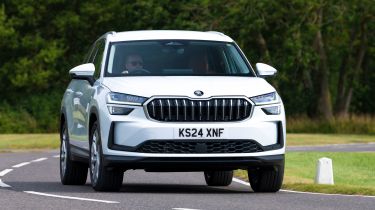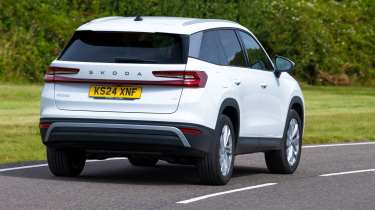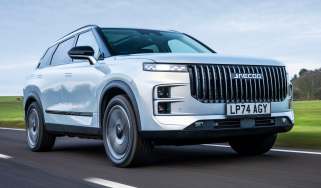Skoda Kodiaq review - Engines, drive & performance
“The Skoda Kodiaq’s driving experience isn’t anything to write home about, but it’s refined and comfortable”
The Skoda Kodiaq’s engine options haven’t changed massively in comparison to the outgoing model’s, but the 1.5-litre engine is now mild-hybrid assisted. The Kodiaq is still offered with diesel options which use a 2.0-litre engine in two different power outputs, one of which comes with four-wheel drive. All Skoda Kodiaq models are now automatic.
One option that’s a brand-new addition to the Kodiaq lineup is the Kodiaq iV plug-in hybrid. While the last-generation Superb and Octavia had this as an option, it’s only now that the brand’s largest SUV has adopted the technology. It uses a 1.5-litre petrol engine and electric motor combined to produce 201bhp with a claimed 8.4-second 0-62mph time.
While driving pleasure isn’t really a focus for a car like this, the Skoda Kodiaq performs well. We think it’s very refined, offers a smooth ride and the petrol and diesel engines feel capable enough for a car of this size. If you want excitement you might be slightly disappointed, and one of BMW’s SUVs is a better bet.
Whichever wheels you spec – the Kodiaq is offered with 18 to 20-inch wheels – ride quality is good thanks to the soft, high-riding suspension that smooths out potholes.
More reviews
On its own, the Kodiaq iV’s electric motor produces 114bhp, but while that might not seem a lot for a car of this size, it feels surprisingly punchy – so much so that we were able to use it in EV mode for extended periods of time, with the combustion engine only chiming in once under heavy acceleration. When the 1.5-litre engine does engage it can sound a little strained and noisy. While it may have the highest power output of the range, the plug-in hybrid is still best suited to a relaxed driving style where it feels the most refined.
The Kodiaq iV rides comfortably but there is a bit of body roll through corners and the overall feel is floaty. One gripe we have is that there can be a slight fidget over smaller road imperfections, which is something we have experienced also in the Superb. We think it’s a good all rounder, though, and it’s not quite as wallowy as some other large SUVs.
Is the Skoda Kodiaq good to drive in town?
The Skoda Kodiaq’s mild-hybrid petrol engine or PHEV option will be the best option to go for if you plan to use it more around town. With the PHEV’s impressive electric range and punchy electric motor that works particularly well at lower speeds, you can waft along around town silently, and the petrol engine felt well integrated, kicking in seamlessly when needed.
Is the Skoda Kodiaq good to drive on long journeys?
While the Kodiaq’s suspension makes it feel somewhat wallowy on twistier roads, it feels composed at higher speeds, making it a good motorway cruiser. While drivers covering many motorway miles will be better off with one of the diesels, even the mild-hybrid petrol felt impressively refined when cruising along, though the engine can get noisy under heavy acceleration.
Is the Skoda Kodiaq good to drive on B-roads?
The Skoda Kodiaq isn’t designed for B-road blasts, but you do get the option of DCC (Dynamic Chassis Control) which tweaks the suspension settings for different scenarios. There are seven drive modes: Normal, Comfort, Eco, Sport, Offroad, Snow and Individual (the latter two are only available on the four-wheel drive models). You can also tweak the stiffness of the suspension to 15 different levels, and we found setting this to a harder setting helped to limit body roll on fast, twisty roads, but it never feels particularly sporty, and is best suited to casual, relaxed driving.
Petrol models
There’s just one petrol model available for the Skoda Kodiaq, and while its 1.5-litre size might seem too small for such a large SUV, it’s perfectly capable and gets mild-hybrid assistance and feels pretty punchy. Paired with its automatic DSG gearbox it feels very responsive and would suit the majority of buyers.
|
Model |
Power |
0-62mph |
Top speed |
|
1.5-litre mild-hybrid petrol engine |
148bhp |
9.7 seconds |
128mph |
Diesel models
The majority of the Skoda Kodiaq’s engine lineup is actually diesel, despite many manufacturers abandoning this fuel. Both use a version of its 2.0-litre TDI engine with either two-wheel drive or four-wheel drive. The entry-level two-wheel drive model gets the same 148bhp output as the mild-hybrid petrol, but feels like it has a lot more grunt on the move. It feels smooth and refined.
The four-wheel drive model, despite its 52bhp higher power figure, doesn’t feel much quicker in reality, and we found it to be noisier, too. We’d only recommend going for this model if you really need the four-wheel drive for some moderate off-road driving or heavy-duty towing, but even the two-wheel drive version felt comfortable on the rocky terrain we tested it on.
|
Model |
Power |
0-62mph |
Top speed |
|
2.0-litre TDI |
148bhp |
9.6 seconds |
127mph |
|
2.0-litre TDI 4x4 |
190bhp |
8 seconds |
134mph |
Plug-in hybrid models
The Skoda Kodiaq iV makes use of that same 1.5-litre petrol engine used in the entry-level car, but is paired with an electric motor and battery for 201bhp. We found it to be very punchy, yet smooth. Only under harsh acceleration does the plug-in hybrid really falter, because the combustion engine can sound strained when pushed – it’s much better to take it easy.
Carbuyer notes
“The Skoda Kodiaq offers strong overall refinement, a smooth ride and a range of competent engines, giving the Kodiaq plenty of competence, if not outright excitement, on the road.” Alastair Crooks, Senior News Reporter
Which Is Best?
Cheapest
- Name1.5 TSI e-TEC SE 5dr DSG
- Gearbox typeAuto
- RRP£37,870
Most Economical
- Name1.5 TSI iV 204 SE 5dr DSG
- Gearbox typeAuto
- RRP£41,935
Fastest
- Name2.0 TSI vRS 4X4 5dr DSG [7 Seat]
- Gearbox typeAuto
- RRP£53,195

















